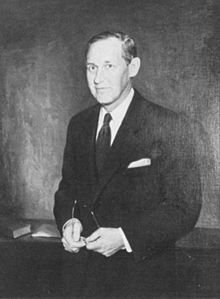Lorena Hickok
Lorena Alice "Hick" Hickok (March 7, 1893 – May 1, 1968) was an American journalist and long-term friend and possibly romantic partner[1] of First Lady Eleanor Roosevelt.
The closeness of their relationship compromised Hickok's objectivity, leading her to resign from the AP and work as chief investigator for the Federal Emergency Relief Administration (FERA).
She later promoted the 1939 New York World's Fair, and then served as executive secretary of the Women's Division of the Democratic National Committee, living mostly at the White House, where Hickok had a conjoining room with the First Lady.
Addison had no polite words for his eldest daughter, but the experience was a liberating one for the girl, who left the train with the realization that she was now an adult and her father could no longer strike her.
[5] Hickok made her way to Gettysburg, South Dakota, where she met and worked for a kind, elderly lady named Mrs. Dodd, who helped her to learn how to be an adult, teaching the teenager basic skills such as how to wash her hair.
[8] Unable to fit in at college, Hickok found work covering train arrivals and departures and wrote personal interest stories at The Battle Creek Evening News for $7 a week.
[9] In an attempt to follow in the footsteps of her role model, novelist and former reporter Edna Ferber, she joined the Milwaukee Sentinel as its society editor and then moved on to the city beat, where she developed a talent as an interviewer.
[8] She interviewed celebrities, including actress Lillian Russell, pianist Ignacy Paderewski, and opera singers Nellie Melba and Geraldine Farrar, gaining a wide audience.
[19] In 1932, Hickok convinced her editors to allow her to cover Eleanor Roosevelt during her husband's presidential campaign and for the four-month period between his election and inauguration.
"[33][34] Early in the Roosevelt administration, Hickok is credited with pushing Eleanor to write her own newspaper column, "My Day", and to hold weekly press conferences specifically for female journalists.
[37] Eleanor then helped Hickok obtain the position as a Chief Investigator for Harry Hopkins' Federal Emergency Relief Administration (FERA), where she conducted fact-finding missions.
[39] Hickok traveled in a car that Eleanor had brought her which she named Bluette, heading first for the coal-mining districts of western Pennsylvania to enter the region of Appalachia.
I visited one group of 45 blacklisted miners and their families who had been living in tents two years...Most of the women you see in the camps are going without shoes or stockings...It's fairly common to see children entirely naked".
[43] The same month she wrote from Minnesota that the farmers were growing unhappy with President Roosevelt as one farm leader told her: "We were promised a New Deal...Instead, we have the same old stacked deck".
[44] She reported some of the normally conservative farmers of South Dakota were blaming capitalism for their plight and were turning towards Communism as Communist meetings on the Great Plains were well attended.
[50] In January 1934, she reported that she had seen in rural Georgia "half-starved Whites and Blacks struggle in competition for less to eat than my dog gets at home, for the privilege of living in huts that are infinitely less comfortable than his kennel...If there is a school system in the state, it simply isn't functioning.
[54] In March 1934, Hickok accompanied Eleanor on a fact-finding trip to the U.S. territory of Puerto Rico, reporting afterward to Hopkins that the island's poverty was too severe for FERA to usefully intervene.
[52] Owing to religious and ethnic prejudices, Hickok reported "the people on relief in that town are subjected to a treatment that is almost medieval in its stinginess and stupidity".
[58] The mayor of Toledo, Ohio told Hickok: "I have seen thousands of these defeated, discouraged, hopeless men and women, cringing and fawning as they come to ask for public aid.
[59] In February 1934, Time called her "a rotund lady with a husky voice, a peremptory manner, baggy clothes", a description that wounded Hickok.
[63] From the Imperial Valley in California, she reported that the wealthy landowners were "simply hysterical" about the prospect of the Communists organizing the masses of the unemployed to lead a revolution.
[62] In 1937, Roosevelt wrote to Hickok that "I never meant to hurt you in any way, but that is no excuse having done it...I am pulling back from all my contacts now...Such cruelty & stupidity is unpardonable when you reach my age.
[12] On the advice of Roosevelt's secretary, Malvina Thompson, Hickok then sought work in New York with public relations man and politician Grover Whalen.
Because Hickok rented both a country home and an apartment, she often faced financial problems despite her good salary during these years, and Roosevelt occasionally sent her small gifts of money.
[12] With help from Roosevelt, Hickok became the executive secretary of the Women's Division of the Democratic National Committee (DNC) in February 1940, doing groundwork for the 1940 election.
Also during this time, she formed an intense friendship with Marion Janet Harron, a United States Tax Court judge who was ten years younger than she[67] and almost the only person to visit her at the White House.
The relationship ended when Roosevelt traveled to Geneva to work on drafting the Universal Declaration of Human Rights and took interest in her male doctor, Swiss physician David Gurewitsch.
[71] She used the condition to avoid social situations, claiming it made it difficult for her to dine with others, but Hickok had always enjoyed her own company or that of her dogs, Prinz and Mr. Choate.
Hickok willed her personal papers to the Franklin D. Roosevelt Presidential Library and Museum in Hyde Park, part of the US National Archives.
[74] Based on these letters, Terry Baum and Pat Bond wrote the play, Hick: A Love Story, the Romance of Lorena Hickok and Eleanor Roosevelt.



